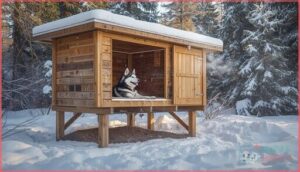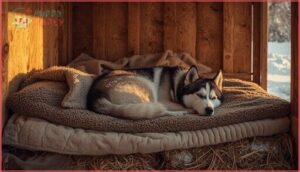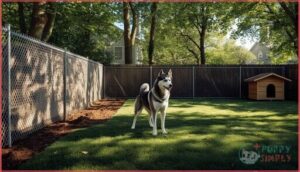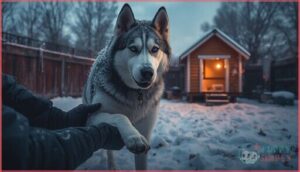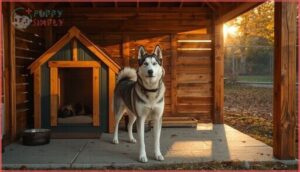This site is supported by our readers. We may earn a commission, at no cost to you, if you purchase through links.
Your husky’s thick double coat isn’t just for show—it’s an evolutionary marvel designed to withstand temperatures that would send most dogs running indoors. Siberian Huskies were bred to pull sleds across frozen tundra, sleeping in snow banks between runs, which means they’re naturally equipped for outdoor life in ways that might surprise you.
But before you assume your husky can simply camp out in the backyard year-round, there’s a critical difference between what their ancestors endured and what responsible modern ownership requires. The answer to whether huskies can live outside isn’t a simple yes or no—it depends on your climate, the shelter you provide, and your commitment to meeting their complex physical and emotional needs.
Table Of Contents
- Key Takeaways
- Can Huskies Live Outside Safely?
- Essential Shelter Requirements for Huskies
- Outdoor Space and Security Needs
- Health and Safety Considerations
- Acclimating Huskies to Outdoor Living
- Special Care for Outdoor Huskies
- Frequently Asked Questions (FAQs)
- How can I prevent my husky from barking excessively while it’s outside?
- What are some ways to provide mental stimulation for my husky while it’s outside?
- How can I ensure that my husky has a safe and secure outdoor space?
- Can huskies live outside year-round alone?
- How often should outdoor huskies be groomed?
- What toys work best for outdoor huskies?
- Do outdoor huskies need different nutrition plans?
- When should huskies come inside at night?
- Conclusion
Key Takeaways
- Huskies can live outside safely in cold climates if you provide an insulated, elevated shelter with proper bedding, but their thick double coat makes them vulnerable to heat stress above 70°F, requiring careful monitoring in warmer regions.
- Your outdoor husky needs secure fencing at least six feet tall (sometimes eight) with underground barriers to prevent escape, plus 1-2 hours of daily exercise and mental stimulation to avoid destructive behaviors like digging and excessive barking.
- Gradual acclimation over 2-4 weeks is essential when transitioning your husky outdoors, and you’ll need to maintain daily human interaction since 89% of huskies show fewer behavioral problems with consistent contact while isolation causes destructive habits in 71% of cases.
- Outdoor living increases your husky’s exposure to parasites (nearly double the heartworm infection rate of indoor dogs), requires monthly preventive treatments, regular veterinary check-ups, and daily monitoring for signs of hypothermia below 14°F or heatstroke symptoms in summer.
Can Huskies Live Outside Safely?
Yes, huskies can live outside safely, but it’s not as simple as just putting them in the backyard and calling it a day. Their ability to thrive outdoors depends on several factors, including their natural adaptations, the climate where you live, and the quality of care you provide.
Let’s look at what makes huskies suited for outdoor life and where potential problems can arise.
Breed Traits and Outdoor Suitability
Siberian Huskies were built for the outdoors. Their husky temperament combines independence with loyalty, while their outdoor endurance stems from Asiatic wolf ancestry. Males usually reach 20-27 kg, females 16-23 kg. Their thick fur coats and social needs create a balancing act for outside dogs.
- Exercise requirements: You’ll need to provide 1-2 hours of daily activity to prevent destructive boredom behaviors like digging.
- Prey drive: Your Husky may chase cats, rabbits, and rodents due to strong instinctual behaviors.
- Physical build: The breed’s compact, muscular frame backs long-distance work in challenging conditions.
To ensure their overall well-being, it’s essential to understand their high energy needs and provide adequate care.
Cold Weather Adaptations
Your Husky’s cold climate adaptation is outstanding. Their double coat allows survival in temperatures down to -50°F through thermal regulation and insulating layers. Specialized paw pads use counter-current heat exchange for frost resistance, while natural oils provide water repellency. Cold acclimation triggers metabolic adaptation, increasing calorie burn for warmth.
These traits make outdoor dog safety manageable in winter, though proper husky care and maintenance remains essential. Understanding their cold tolerance mechanisms is vital for providing the right environment.
Risks in Warm and Hot Climates
While huskies excel in cold, hot weather poses serious risks. Heat stress prevention becomes critical above 70°F—much lower than other breeds. Their thick coat traps warmth, making canine thermoregulation inefficient in summer.
Watch for heatstroke symptoms:
- Excessive panting and disorientation
- Dry nose and vomiting
- Collapse or lethargy
Climate change impact increases these dangers. Caring for huskies in hot climates requires shade, cool water, and avoiding peak heat hours for thermal comfort and husky health and safety.
Essential Shelter Requirements for Huskies
If your Husky will spend significant time outdoors, their shelter becomes their lifeline in extreme weather. A proper setup protects them from cold, wind, rain, and heat while giving them a safe place to rest.
Let’s break down the three essential elements every outdoor Husky shelter needs to keep your dog healthy and comfortable.
Insulated Dog House Design
For outdoor dogs living in cold climates, an insulated dog house is your first line of defense. Insulation materials like rigid foam panels or reflective foil create thermal barriers that keep internal temperatures 10–15°F warmer than outside.
Proper dog house sizing matters too—just enough room for your Husky to turn and curl up maximizes energy efficiency and heat retention.
Weatherproofing and Elevation
Beyond insulation, you’ll need sturdy moisture control and elevated platforms to keep your Husky dry and warm. Rain and melting snow can quickly saturate an unprotected shelter, compromising even the best insulation materials.
Effective weatherproofing for cold climate dog breeds includes:
- Waterproof coatings sealing seams to block up to 90% of wind-driven water penetration
- Ventilation systems with rear panels reducing interior humidity by 18% during wet weather
- Elevated platforms raised 4 inches to prevent 85% of ground moisture intrusion and boost airflow
Bedding and Warmth Solutions
The right bedding makes all the difference in cold weather dog shelter performance. Your Husky needs insulation materials that retain warmth without trapping moisture—straw and fleece work well, while heated bedding prevents temperature drops below 39°F.
| Bedding Type | Key Benefit |
|---|---|
| Memory Foam | Joint support with heat retention |
| Heated Pads | Prevents body temperature loss |
| Canvas Blankets | Durable, claw-resistant warmth |
Layer thermal blankets over outdoor mattresses for maximum warmth retention.
Outdoor Space and Security Needs
Beyond providing a solid shelter, you’ll need to create a secure outdoor environment that keeps your Husky safe while giving them room to move. These dogs are notorious escape artists with impressive jumping and digging skills, so your setup needs to account for their athletic abilities.
Let’s look at the key elements that make an outdoor space both functional and secure for your Husky.
Fencing Height and Escape Prevention
Your husky’s escape artistry isn’t just impressive—it’s dangerous. These determined dogs can clear six-foot fences with ease, making perimeter fencing a critical safety measure for outdoor dog living.
- Install fencing at least six feet tall, though athletic huskies may require eight-foot barriers to prevent successful jumps
- Bury fence materials 12 inches underground or install concrete footers to stop digging prevention failures at weak points
- Choose smooth, solid fence materials over chain link, which huskies climb using their footholds and scrambling technique
- Secure gates with dual-action or lockable latches, as basic locks won’t stop these problem-solvers from manipulating openings
- Add paving stones along interior fence lines to reduce tunneling attempts by 78% in monitored outdoor environments
Regular security checks protect your husky’s safety while supporting healthy dog socialization and interaction during supervised outdoor activities.
Yard Layout for Exercise
Your husky’s outdoor space needs strategic planning to channel their boundless energy. Design distinct exercise zones—a digging pit, agility courses with jumps and tunnels, and open play areas for running.
Research shows dogs thrive with 600 square feet minimum, but varied terrain beats sheer size. Rotate yard accessories and outdoor activities weekly to maintain engagement, supporting healthy dog socialization and interaction while preventing the boredom that fuels destructive behavior.
Safe Outdoor Environment Considerations
Your outdoor setup won’t work without proper climate control and weather safety measures. Position your husky’s shelter to capture winter sunlight while blocking prevailing winds, and guarantee constant water access to prevent dehydration-related temperature regulation failures.
Guard against environmental risks by managing these outdoor hazards:
- Sun protection in tropical areas where solar radiation reaches 1200 W/m² during peak hours
- Yard chemicals including toxic pesticides and fertilizers that endanger canines
- Wildlife intrusions through routine parasite checks and visible monitoring from your home
Health and Safety Considerations
Even with the right shelter and secure yard, keeping your Husky outside means staying alert to health risks that can sneak up fast. Cold-weather breeds aren’t invincible—they can still face frostbite, overheating in warmer months, and threats from parasites or wildlife.
Let’s walk through the key safety concerns you need to monitor.
Preventing Hypothermia and Frostbite
Even a cold-hardy husky faces hypothermia risk when temperatures drop below −10–C (14–F), especially with wet fur compromising insulation. You’ll want to limit outdoor time to three hours in extreme cold and provide thermal safety through heated bedding that maintains shelter warmth 3–5–C above outside air.
Protective paw balms reduce cold injury by 34%, while straw bedding offers enhanced winterization compared to blankets alone.
Monitoring for Overheating
While cold poses one danger, heat presents an equally serious threat to your husky’s health. Excessive panting, water-seeking behavior, and bright-red gums signal overheating risk—especially when outdoor temperatures exceed 32°C (90°F).
You’ll need to schedule activities during early morning or evening hours, provide constant shade and fresh water, and use cooling mats or shallow pools as effective summer pet care strategies for proper temperature control and heatstroke prevention.
Protection Against Wildlife and Parasites
Beyond temperature extremes, wildlife and parasites pose significant outdoor hazards requiring proactive disease prevention measures. Outdoor pets face heartworm infection rates nearly double those of indoor dogs, while tick-borne illnesses affect 4.8% nationwide.
You’ll need monthly FDA-approved parasite control treatments, which reduce infestations by 89%. Regular veterinary screenings, secure fencing as wildlife deterrents, and daily yard maintenance protect your husky’s canine health and wellness effectively.
Access to Fresh Water and Food
Your husky’s water quality and outdoor nutrition directly impact disease resistance and thermoregulation. Daily water needs range from 40 to 80 milliliters per kilogram of body weight, increasing with activity and temperature.
Proper husky care and maintenance includes:
- Cleaning water bowls daily to prevent bacterial contamination
- Using heated bowls in freezing conditions to maintain liquid access
- Providing weather-protected feeding stations for fresh feeding
- Adjusting caloric intake 10-15% higher during colder months
Secure placement protects dog health and wellness while deterring wildlife exposure.
Acclimating Huskies to Outdoor Living
Moving your Husky outdoors isn’t something you should rush into overnight. A gradual shift gives your dog time to adjust physically and mentally, building up the natural defenses they need to thrive outside.
Let’s walk through the key steps to make this shift as smooth and safe as possible.
Gradual Transition Steps
Think of the acclimation process as training for a marathon—you wouldn’t start with 26 miles on day one. Begin outdoor introduction with short 1–2 hour sessions during cooler morning or evening periods, gradually extending duration over 2–4 weeks.
Studies show this environmental adaptation approach requires about 29 days for full adjustment. Once your husky manages daytime exposure comfortably, introduce supervised nighttime periods before attempting full overnight stays.
Monitoring Coat Development
Your Siberian Husky’s coat development offers a reliable window into their readiness for outdoor living. Watch for these measurable changes as you increase outside time:
- Coat thickness: Undercoat growth reaches approximately 0.25 inches per week during cold exposure
- Shedding patterns: First major coat blow occurs around 12 months of age
- Fur density: Guard hair and undercoat ratio shifts noticeably before winter
- Topcoat changes: Primary guard hairs become coarser and more weatherproof
- Undercoat growth: Full adult double coat usually develops by 15 months
Regular grooming sessions help you track these physical adaptations throughout the shift process.
Behavioral and Emotional Well-being
Emotional stability hinges on consistent human contact. Studies show 89% of huskies display fewer behavior problems when you interact with them daily. Without social bonds, you’ll see destructive behaviors in 71% of outdoor dogs—chewing, digging, excessive howling.
Huskies need daily human interaction to thrive—89% show fewer behavior problems with consistent contact, while isolation breeds destructive habits in 71% of outdoor dogs
Mental stimulation through agility training and group play reduces stress by lowering cortisol levels approximately 18%, supporting both mental health and animal welfare.
Special Care for Outdoor Huskies
Keeping your husky outdoors isn’t a set-it-and-forget-it arrangement. These dogs need consistent care, regular health monitoring, and plenty of interaction to thrive outside your home.
Let’s look at the key responsibilities you’ll need to handle as an owner of an outdoor husky.
Regular Veterinary Check-Ups
Your outdoor Husky needs consistent veterinary care to catch problems before they become emergencies. Annual check-ups form the backbone of preventive dog health and wellness, with costs ranging from $25 to $186 per visit.
Schedule these essential health screenings:
- Vaccination schedules and parasite control – rabies, distemper, heartworm testing ($35-$75), and worming checks
- Eye examinations and dental care – breed-specific screenings for hereditary conditions
- Blood work and nutrition advice – organ function tests ($80-$200) twice yearly for seniors over six
Exercise and Mental Stimulation Needs
Even dogs who live outside aren’t self-exercising creatures—your Husky needs structured exercise and activity every single day. Adult Huskies require at least two hours of vigorous physical activity, including running, hiking, or canine behavior and training sessions. Without this exercise routine, outdoor dog care falls short, leading to escape attempts and destructive behaviors.
Pair physical activity with mental stimulation through cognitive training and play therapy. Studies show proper enrichment reduces problem behaviors by over 60% in outdoor Huskies.
| Activity Type | Examples |
|---|---|
| Physical Exercise | Running, sledding, agility courses, frisbee |
| Mental Challenges | Puzzle toys, scent games, new command training |
| Interactive Play | Hide-and-seek, treat hunts, tug-of-war |
| Sensory Enrichment | Varied walking routes, environmental exploration |
Owner Responsibilities and Time Commitment
Living with an outdoor Husky isn’t a set-it-and-forget-it arrangement. Ontario regulations mandate daily checks for health monitoring, with owner supervision throughout the day to guarantee safety and emotional well-being.
You’ll manage feeding schedules, grooming needs at least three times weekly, and emergency planning for severe weather.
These pet owner responsibilities demand consistent time investment—outdoor dog care and Husky training require your active, ongoing commitment.
Frequently Asked Questions (FAQs)
How can I prevent my husky from barking excessively while it’s outside?
Barking triggers like passing cars or wildlife can turn your outdoor dog into a canine alarm system.
Address this with noise reduction barriers, outdoor enrichment activities, quiet commands, and calming techniques to promote better behavior.
What are some ways to provide mental stimulation for my husky while it’s outside?
Keep your husky mentally sharp with puzzle toys, interactive training sessions, and outdoor games like hide-and-seek.
Rotate environmental enrichment items weekly, add sensory play elements, and schedule regular social interaction to prevent boredom-related behaviors.
How can I ensure that my husky has a safe and secure outdoor space?
Start with secure fencing at least six feet tall and buried underground for escape prevention.
Remove outdoor hazards, provide a weather-protected dog house with proper bedding, and inspect your yard regularly for safe outdoor living.
Can huskies live outside year-round alone?
Huskies handle harsh, cold climates confidently but shouldn’t stay solo year-round without shelter, socialization, and veterinary oversight.
Outdoor acclimation works best when you balance their physical cold weather adaptation needs with essential emotional interaction and year-round care.
How often should outdoor huskies be groomed?
Weekly brushing works for mild weather, but increase to 3–4 times during shedding seasons when your Husky’s coat blows. Daily attention prevents matting and keeps that double coat doing its job.
What toys work best for outdoor huskies?
While outdoor pets often destroy standard toys, your Husky needs durable chew options, fetch toys, interactive puzzles, and squeaker toys.
These support dog exercise and activity, prevent destructive dog behavior, and provide essential mental stimulation outdoors.
Do outdoor huskies need different nutrition plans?
Yes, your outdoor husky needs a different nutrition plan. Cold climate pet care demands higher caloric intake—up to 87 kcal/kg/day in winter—with macronutrient ratios favoring a high protein diet and seasonal feeding adjustments for proper nutrient balance.
When should huskies come inside at night?
Think of nighttime cold like a slow drain on your husky’s energy reserves. Bring them inside when temperatures drop below 20°F, as prolonged cold stress increases frostbite risk and hypothermia prevention becomes critical for winter safety.
Conclusion
You might worry that keeping your husky outdoors means sacrificing the bond you share, but daily interaction remains non-negotiable regardless of living arrangements. With proper shelter, climate considerations, and consistent engagement, huskies can live outside safely in appropriate environments.
However, their well-being depends entirely on your commitment to meeting their physical, mental, and emotional needs. An outdoor husky isn’t a low-maintenance option—it’s a different kind of responsibility that demands equal dedication.
- https://www.reddit.com/r/dogs/comments/10ug9xz/how_cold_is_too_cold_to_leave_a_husky_outside_all/
- https://www.huskyhavenfl.org/hhofl-blog/2022/12/23/huskies-do-live-happily-in-floridas-hot-weather
- https://pmc.ncbi.nlm.nih.gov/articles/PMC10486465/
- https://wagwalking.com/sense/can-husky-dogs-live-in-hot-weather
- https://vetster.com/en/wellness/common-outdoor-hazards-for-your-dog



